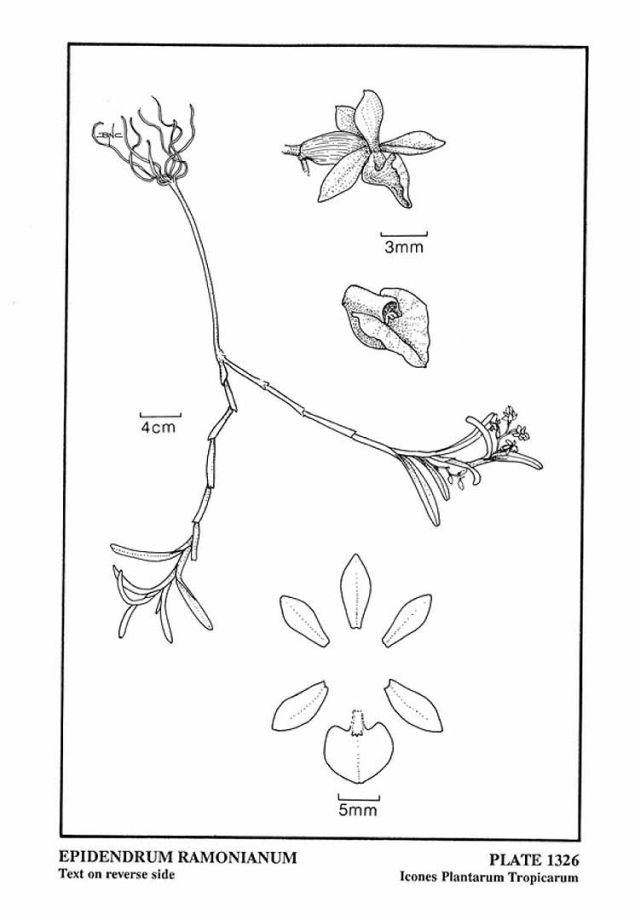

Epidendrum ramonianum Schltr. 1923 GROUP Ramosum SUBGROUP Platystigma
Drawing by © Dodson and The Plant Illustration Webpage
Specimen by © Oak-Ames Herbarium and Epidendra Webpage
Drawing by © Jimenez, Hágsater & E.Santiago and The AMO Herbario Website



 LATE
LATE MID
MID
Common Name The San Ramon Epidendrum [A town in Costa Rica]
Flower Size 1" [2.5 cm]
Found in Costa Rica in cloud forests and pastures at elevations of 1150 to 2200 meters as a giant sized, warm to cold growing epiphtye with a much branching, cane-like, terete, tall, thick main stem, branches short, producung new branches from the subapical internodes and carrying all along the main stem, deciduous when branched, branches with 2 to 4, aggregate towards the apex, coriaceous, narrowly lanceolate to oblong-elliptic, bilobed to retuse leaves that blooms in the summer through mid fall on a terminal, erect, distichous, from the main stem and the branches, arching, short laterally compressed, straight, fractiflex inflorescence with 1 to 2, tubular, acuminate, imbricating bracts and conduplicate, longer than the ovary, non-imbricating, oblong-triangular, acuminate floral bacts and carrying 3 to 6, simultaneously opeing, distichous, very fragrant, white flowers with the lip facing the rachis and a sometimes green lip.
Distinguished by the narrowly oblong-elliptic, bilobed to retuse leaves, a racemose inflorescence carrying white flowers with .08 to .12" [2 to 3 mm] wide, elliptic-lanceolate, acute sepals, a concave, semi-orbicular, basally truncate lip with a laminar callus, a short column that widens towards the apex, and a strongly arcuate ovary.
"Epidendrum ramonianum belongs to the GROUP Ramosum which is characterized by the monopoclial, branching stems, the distichous inflorescence, and the single callus, and the GROUP Ramosum SUBGROUP Platystigma which has monopodial, erect plants with a clear primary stem; branching occurs from the axil of the leaves, proclucing few, short, small-Ieaved branches, and these produce successive, short branches from a subapical internode, thus an old plant has numerous branches, these progressively made of fewer elements, and often lacking the juvenile, long leaves of the main stem· at this stage the plant attains full flowering and often dies. The species is distinguished by its 3 to 6 flowered inflorescence, the very fragrant flowers, white, column rarely green, ovary forming a 90° angle with the column, sepals lanceolate, acute, .12 to .16" [3 to 4 mm] wide, lip subcordate, sometimes apiculate, callus laminar, tridentate teeth rounded column straight, the promlnent clinandrium somewhat surpassing the body of the column. It is similar to E. platystigma Rchb. f. which has 6 to 9 whlte flowers with a green column, the ovary forming an angle of less than 45° with the column, the lip cordiform. Epidendrum cambellstigma Hágsater & Garcia-Cruz has the base of the lip cordate, the callus entire, apple green flowers wlth a white lip. Epidendrum penneystigma Hágsater & Carda-Cruz has the ovary forming a 60° angle, a reniform lip with the base cordate, and whlte flowers. Hagsater etal 2007
Synonyms
References W3 Tropicos, Kew Monocot list , IPNI ; *Repert. Sp. Nov. Regni. Veg. Beih. 19: 217. Costa Rica Schlechter 1923; Icones Planetarum Tropicarum Plate 1326 Atwood 1989 drawing ok; Icones Orchidacearum 3 Plate 340 Hagsater & Sanchez 1999 see recognition section; Icones Orchidacearum 3 Plate 367 Hagsater 1999 see recognition section; Icones Orchidacearum 3 Plate 372 Hagsater 1999 see recognition section; Manual de las Plantas de Costa Rica Vol 3 Hammel, Grayum, Herrera and Zamora 2003; Icones Orchidacearum 9 Plate 975 Hagsater 2007 see recognition section; Icones Orchidacearum 9 Plate 977 Hagsater 2007 drawing ok;
--------------------------------------------------------------------------------------------------------------------------
--------------------------------------------------------------------------------